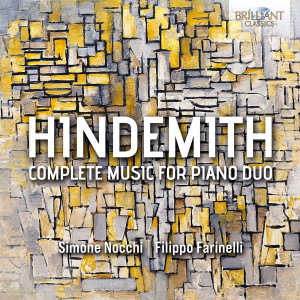
Paul Hindemith (1895-1963)
Complete Music for Piano Duo
Eight Waltzes, op. 6 (1916)
Ragtime (wohltemperiert) (1918)
Symphony Mathis der Maler (1934)
Sonata for piano four hands (1938)
Sonata for two pianos (1942)
Simone Nocchi and Filippo Farinelli (piano duo)
rec. 2018-22, Piano e Forte, Perugia; Fazioli Concert Hall, Sacile; Music Cavern, Perugia, Italy
BRILLIANT CLASSICS 95756 [77]
Hindemith was a very prolific composer and I keep coming across works by him which I had not only not heard, but also not heard of. I am tolerably familiar with his work for solo piano, which includes the Suite 1922, three sonatas and the great Ludus Tonalis. But I had not known that he also wrote a reasonable amount of music for piano duo, meaning both piano four hands duets, and music for players at two pianos. But so he did and here it all is. There is an early work, a transcription and two masterpieces.
The early work is a set of waltzes for piano duet, written in 2016. This was very early in Hindemith’s career, while he was still finding his way compositionally. The idiom of these pieces is more reminiscent of Brahms than of anyone else, apart from the seventh of the set of eight, which is more percussive and rhythmically vital than the rest. In the days when all well-brought-up middle-class children learned the piano, this was the kind of music provided for them to play. They are pleasant enough, but minor.
Next we have the Ragtime (wohltemperiert) of 1921. This was written after Hindemith’s discovery of the ragtime and jazz idioms, which burst upon Europe in the 1910s. More precisely, it seems to have been partly inspired by and modelled on Stravinsky’s Ragtime of 1918. This was written in two versions, one for ensemble and one for piano. Hindemith’s Ragtime is likewise available in two versions, one for orchestra and this for piano duo. It is a joyous, exuberant, noisy piece in either version. The subtitle wohltemperiert (well-tempered) refers to Hindemith’s use of a phrase from Bach’s C minor fugue from the first book of the Well-Tempered Keyboard.
The Symphony Mathis der Maler is Hindemith’s best-known orchestral work. It was written to commission and evokes three scenes from Mathias Grünewald’s Isenheim altarpiece, music which the composer later incorporated into his opera of the same name. It seems that Hindemith himself made this transcription for piano four hands, and the booklet praises his skill in doing so. I have to say that I found the transcription workaday, neat enough, but of little interest given that excellent recordings of the orchestral original are readily available.
The two remaining works are more considerable. The Sonata for Piano Four Hands of 1938 was written just after Hindemith had completed the second volume of his major textbook of composition, in English The Craft of Musical Composition. It is a demonstration of his new-found fluency in his chosen idiom. There are three movements, the first with that angular lyricism which is so characteristic of the composer, the second playful with leaps and jumps in a rather skittish way, and the finale starting with a forthright opening then moving to a faster section. The themes are good and attractive and the whole work is a success. The booklet informs me that Hindemith himself played one of the parts at the premiere.
Finally, we have the Sonata for Two Pianos of 1942. This was written around the time of his solo piano masterpiece, Ludus Tonalis, and shares its quality. It is in five movements, The opening, Chimes, features bell sounds. There is then a light-hearted Allegro, a Canon in that grave and solemn mood which Hindemith first sounded in Mathis der Maler, a Recitative which develops into a slow march and a final Fugue, in which Hindemith demonstrates the same mastery that he shows in the solo piano work. This is a masterpiece, comparable, as the booklet suggests, with Stravinsky’s Concerto for Two Pianos, or with Messiaen’s Visions de l’Amen, also written around the same time.
The performances here are by an Italian team, Simone Nocchi and Filippo Farinelli, who each have solo careers as well as collaborating on recordings. They bring exuberance and precision to these works. The recordings, though made in different venues and at different dates are well matched. Although the programme as a whole is rather a mixed bag, the two sonatas are a real discovery and well worth hearing.
Stephen Barber
Help us financially by purchasing through





















